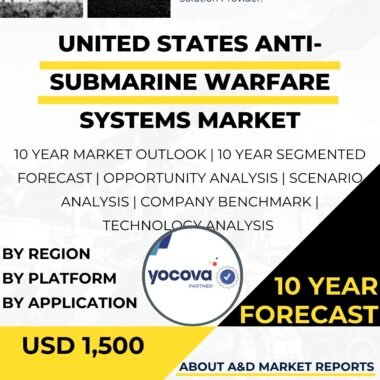Description
South Korea has made substantial advancements in the development and deployment of Underwater Loitering Reconnaissance Systems (ULRS), marking its commitment to enhancing its naval capabilities and maritime security. ULRS, also known as underwater drones, are autonomous or remotely operated vehicles designed to conduct extended missions underwater, including reconnaissance, surveillance, and data collection.
One of the key drivers behind South Korea’s interest in ULRS is the nation’s strategic location in the Asia-Pacific region, where maritime security is of paramount importance. The Korean Peninsula’s proximity to potential threats, including North Korea, makes it imperative for South Korea to maintain robust maritime surveillance and situational awareness. ULRS technology plays a crucial role in achieving this goal by enabling extended underwater missions to monitor and respond to maritime activities effectively.
South Korea’s commitment to technological innovation has positioned it as a frontrunner in the ULRS market. The nation has invested significantly in research and development to create advanced underwater drones equipped with cutting-edge sensors and communication systems. These systems allow for real-time data transmission, enabling rapid decision-making and the timely response to emerging maritime threats.
Furthermore, South Korea’s active participation in international defense collaborations and partnerships has contributed to its ULRS capabilities. Collaborative ventures with global defense companies have facilitated technology transfer and knowledge exchange, allowing South Korea to leverage the expertise of its international partners and integrate advanced ULRS technology into its naval operations.
South Korea’s investments in ULRS extend beyond military applications. The nation recognizes the potential for underwater drones in civilian sectors, including marine research, underwater exploration, and environmental monitoring. This dual-use approach enhances South Korea’s technological expertise and opens opportunities for collaboration between the defense and civilian industries.
In conclusion, South Korea’s progress in the field of Underwater Loitering Reconnaissance Systems underscores its dedication to maritime security and the advancement of its naval capabilities. By embracing technological innovation, fostering international collaborations, and recognizing the dual-use potential of ULRS technology, South Korea positions itself as a significant player in the global ULRS market. As maritime challenges continue to evolve, South Korea’s expertise in underwater drones will play a crucial role in enhancing regional stability and safeguarding its maritime interests.
Table of content
Table Of Contents
1 Market Introduction
1.1 Market Introduction
1.2 Market Definition
1.3 Market Segmentation
1.4 10 Year Market Outlook
2 Market Technologies
3 Global Market Forecast
3.1 Global Market Forecast
3.2 By Size
3.3 By Propulsion
4 APAC Market Trends & Forecast
4.1 Drivers, Restraints And Challenges
4.2 PEST
4.3 Market Forecast
4.3.1 Market Forecast By Size
4.3.2 Market Forecast By Propulsion
4.4 Scenario Analysis
4.5 Key Companies& Profiling
5 South Korea Analysis
5.1 Current Levels Of Technology Maturation In This Market
5.2 Market Forecast
5.2.1 Market Forecast By Size
5.2.2 Market Forecast By Propulsion
5.3 Scenario Analysis
5.4 Country Defense Budget (Historical and 10- year forecast)
5.5 Defense Budget Category Spending- 10- year forecast
5.6 Procurement Analysis
5.7 EXIM Data
5.8 Patents
6 Opportunity Matrix
6.1 By Size
6.2 By Propulsion
7 Scenario Analysis
7.1 Scenario 1
7.1.1 By Size (Scenario-1)
7.1.2 By Propulsion(Scenario-1)
7.2 Scenario 2
7.2.1 By Size (Scenario-2)
7.2.2 By Propulsion(Scenario-2)
8 Company Benchmark
9 Strategic Conclusions
10 About Aviation And Defense Market Reports
Segments
By Size
By Propulsion
List of Tables
Table1: Global Market Forecast, Underwater Loitering Reconnaissance System
Table2: APAC Market Forecast, Underwater Loitering Reconnaissance System
Table3: APAC Market Forecast, By Size
Table4: APAC Market Forecast, By Propulsion
Table5: APAC, Scenario Analysis
Table6: South Korea Market Forecast, Underwater Loitering Reconnaissance System
Table7: South Korea Market Forecast, By Size
Table8: South Korea Market Forecast, By Propulsion
Table9: South Korea, Scenario Analysis
Table 10: South Korea Defense Budget 10 Year Forecast
Table 11: South Korea, Defense Budget Category Spending- 10- year forecast
Table 12: South Korea, Procurement Analysis
Table 13: South Korea, EXIM Data Analysis
Table 14: South Korea, Opportunity Analysis, By Size
Table 15: South Korea, Opportunity Analysis, By Propulsion
Table 16: South Korea, Scenario Analysis, By Size
Table 17: South Korea, Scenario Analysis, By Propulsion
Figure 1: Market Segmentation, South Korea Underwater Loitering Reconnaissance System
Figure 2: Key Technology Analysis, Underwater Loitering Reconnaissance System
Figure 3: Global Market Forecast, Underwater Loitering Reconnaissance System
Figure 4: APAC, Market Forecast, Underwater Loitering Reconnaissance System
Figure 5: APAC, Market Forecast, By Size
Figure 6: APAC, Market Forecast, By Propulsion
Figure 7: APAC, Scenario Analysis
Figure 8: South Korea, Market Forecast, Underwater Loitering Reconnaissance System
Figure 9: South Korea, Market Forecast, By Size
Figure 10: South Korea, Market Forecast, By Propulsion
Figure 11: South Korea, Scenario Analysis
Figure 12: South Korea, Defense Budget 10 Year Forecast
Figure 13: South Korea, Defense Budget Category Spending- 10- year forecast
Figure 14: South Korea, Procurement Analysis
Figure 15: South Korea, EXIM Data Analysis
Figure 16: South Korea, Opportunity Analysis, By Size
Figure 17: South Korea, Opportunity Analysis, By Propulsion
Figure 18: South Korea, Scenario Analysis, By Size
Figure 19: South Korea, Scenario Analysis, By Propulsion
Figure 20: Company Benchmark




